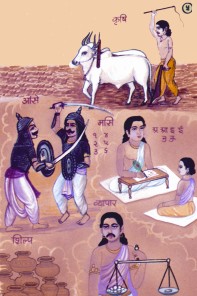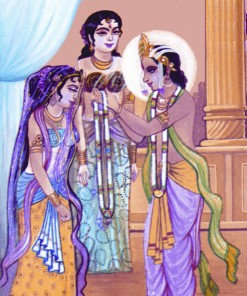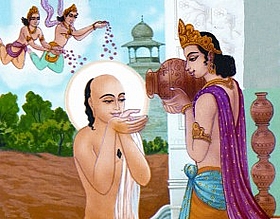Bhagawan Adinath
Time is infinite where there is no beginning or end. It continuously migrates from periods of progress to periods of decline, and one period follows another. According to Jain tradition, a period of progress, known as Utsarpini or the ascending order, is marked with all around improvements such as longer life span, prosperity, and overall happiness. On the other hand, a period of decline, known as Avasarpini or the descending order, is marked with all around deterioration and decline such as a shorter life span, and general gloom. These two periods together make one time cycle. Each Utsarpini and Avasarpini is divided into six eras called Ārās, meaning the spokes of a wheel. The present time is the fifth Ārā of the Avasarpini period. It is also known as Dusham (Unhappy) Ārā. Hindu tradition calls it Kaliyuga.
Until the end of the third Ārā of the current Avasarpini, people were leading a more natural and simple life. The population was small and nature was bountiful. Nature provided all the necessities for human beings so they did not have to exert much effort for obtaining the necessities of life. Trees provided shelter and enough leaves and bark for covering their bodies. With the help of the branches, they could erect huts for protection from rain and extreme weather. When they felt hungry, they could pick their food from the trees and bushes. There was enough flowing water for cleaning their bodies and quenching their thirst. As such, there was no struggle for existence or rivalry for survival, and people spent their lives in peace. The people lived in tribes and had a leader known as a Kulkar or king. Towards the end of the third Ārā, there lived a Kulkar named Nābhirāyā. He could peacefully manage the community of that time. In due course, his beautiful wife, Queen Marudevi, gave birth to Rishabha.

Rishabhdev teaching life skills and trades
The world’s conditions started changing after Rishabha was born. There was an increase in population and nature no longer remained as bountiful as it used to be. This gave rise to a struggle for the acquisition and accumulation of the necessities of life. A sense of jealously and envy also arose in its wake. Nābhirāyā, as the leader of the community, tried to restrain the struggle to the utmost possible extent. In due course, as Rishabha grew to be a bold, intelligent, and enthusiastic young man, Nābhirāyā entrusted the management of the kingdom to him.
Rishabha was a visionary, a thinker, and an inventor. He foresaw that the struggle for survival would become worse unless some system of producing the necessities of life was created. He realized that people could make an effort for obtaining what they need from nature instead of relying exclusively on natural bounties. Being the genius that he was, he evolved the art of crop cultivation and taught people how to grow food and fiber. Thus, he ushered in what we call the age of material civilization.
To make the lives of people more comfortable, he taught them how to make utensils, cook food, build houses, make clothes, cultivate land, and to raise animals like cows and horses. He also developed different arts and crafts whereby a variety of articles could be made from wood, metal, and stone. Thus the first city named Vinita came into existence. This city was later known as Ayodhyā.

Rishabhdev marrying Sunanda and Sumangala
Rishabha was married to Sumangalā and he was also married to another woman named Sunandā who had lost her husband. Rishabha sanctified the system of marriage and institutionalized family life. Thus, a social order was evolved and Rishabha, as the first acknowledged ruler of human society, came to be known as King Rishabhadev. He ruled for a very long time and laid down equitable rules and regulations for ensuring peace and safety within his realm. People of the kingdom loved Rishabhadev for providing peace and happiness.
Rishabhadev had 100 sons. The eldest two, Bharat and Bāhubali, were well known. He also had two daughters, Brāhmi and Sundari. These four children were experts in different arts and crafts. Bharat became a brave warrior and a capable ruler. Jain literature indicates that India was named ‘Bhārat’ after him. Bāhubali, true to his name (Bāhu means arm and Bali means mighty), was known for his exceptional arm strength. Brāhmi was a very educated girl. She evolved the art of writing and developed the Brāhmi script in which most of the scriptures were written. Her sister, Sundari, cultivated an exceptional talent in mathematics.
Rishabhadev had every reason to be proud and happy with his achievements. However, one incident occurred to make him change his way of thinking. Once while he was watching a dance, the dancer suddenly collapsed and died. Rishabhadev became very disturbed by this incident. He started pondering over the death of the dancer and realized that every phenomenon and every situation in the universe undergoes changes and that no situation remains permanent. He decided to renounce worldly life in search of lasting happiness and distributed his kingdom among his children. He gave Bharat the city of Vinita and entrusted the city of Taxshilā to Bāhubali. To the remaining 98 sons, he distributed other parts of his vast kingdom. Then, he renounced all his possessions and became a monk in search of the ultimate truth. Four thousand of his associates and followers also joined him in renunciation.
As a monk, Rishabhadev traveled from place to place. He remained in a state of continuous meditation and did not think of food or water. Since Rishabhadev remained deeply immersed in meditation he could not guide his followers on how they should live their life as monks. His followers could not fast like him and they did not want to go back. They were confused and started behaving on their own accord. They decided to live on fruits and vegetables obtained from the nearby jungles.
After sometime, Rishabhadev could see their miserable condition. Jain monks are not supposed to pick any fruits and vegetables from trees by themselves but go to laypeople’s house for alms (for food). He therefore decided to demonstrate the way a monk is supposed to live. Rishabhadev started going from house to house for alms in silence. However, people did not know what to offer Rishabhadev who was once their beloved king. They offered him ornaments, their homes, and other valuable items but no one thought of offering food. As a result, Rishabhadev had to continue fasting day after day.

Shreyans offering sugarcane juice to Rishabhdev
After undergoing fasts for 400 days (thirteen months and nine days), Rishabhadev passed by a sugarcane farm located near the town of Hastināpur. The farm belonged to his great grandson, Shreyāns. He offered sugarcane juice to his Great Grandfather. Thus, Rishabhadev ended his long fast with sugarcane juice. It was the third day of the bright half of the month of Vaisakha known as Akshaya Tritiya day. This day usually falls in the month of May. In commemoration of this event, people observe a similar austerity known as Varsitapa for 400 days. As it is not possible for people to fast that long, they fast on alternate days; and at the end of 400 days, they break their fast with sugarcane juice on Akshaya Tritiya (Akhātrij) day. After years of rigorous austerities and the search for truth, Rishabhadev attained Keval-jnān while meditating under a banyan tree on the 11th day of the dark half of Falgun (which usually falls in March). This is known as the ultimate enlightenment and the attainment of Omniscience. In order to guide people towards the right path, he established the fourfold religious order comprising of monks (Sādhus), nuns (Sādhvis), laymen (Shrāvaks), and laywomen (Shrāvikās). This order is known as the Jain Sangha.
Rushabhsen, the son of King Bharat became the head of the monks and Brāhmi and Sundari headed the order of nuns. As a founder of the religious order known as Tirtha, Rishabhadev is the first Tirthankar of the current Avasarpini part of the time cycle. Thus being the first Tirthankar or Lord, he is also known as Ādināth (Ādi means the first or the beginning and Nāth means the Lord). Thereafter he lived long and taught the truth about everlasting happiness.
Along with the rules of ascetic life, Bhagawān Rishabhadev taught the noble and moral ways of a householder’s life. The popular Jain period of austerity, known as Varsitapa, is observed in commemoration of the 400 days of fasting that Rishabhadev did before receiving food from a layperson. Offering pure food to a Sādhu is one of the noblest acts for a layperson. In this manner, even if we cannot follow the ascetic life, we can show our reverence by offering food to a Sādhu. Our scriptures have praised Dāna Dharma (donation) of Shreyāns generously.